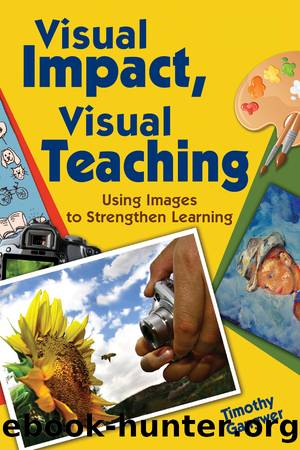Visual Impact, Visual Teaching by Timothy Gangwer

Author:Timothy Gangwer
Language: eng
Format: epub
Publisher: Skyhorse
Published: 2015-01-15T00:00:00+00:00
Activity 4. Visual Metaphors
Ask students to make images (without other people in them) that are visual metaphors for their personalities. A visual metaphor can reflect values, self-concept, interests, goals, opinions, and so on. Have students create three visual metaphors for who or what they used to be, who or what they are now, or who or what they hope to be. Discuss these visual metaphor photographs in class. âDo others see you in the way you see yourself?â
Activity 5. Point of View
Ask students to imagine themselves as nonhuman subjects or objects. This might include plants, animals, or natural or manufactured objects. Have them list the things that might be important to them in their new imagined role. Who or what would they interact with on a regular basis? After discussing their lists, ask students to make images from the point of view they have chosen to imagine. When they have made their photographs, use them as a basis for stories, plays, or presentations. This activity is a good way to help students visualize and learn processes. In a science lesson, you might assign different students different roles as objects and ask them to imagine their reactions to gravity, heat, acceleration, or other physical forces. This activity is also good for building emphatic skills.
Activity 6. Phonetography
Assign students letters of the alphabet. Ask each student to find and photograph something that starts with the same initial consonant or vowel sound (Aâacorn, Bâbook, Câcow, and so on.). Post images with letters in a visual alphabet. Highlight tough letters like Q and X. âForm words using phonetic photos.â
Activity 7. See What You Mean
Have students make photographs representing various parts of a sentence (nouns, verbs, adjectives). âPut them in order and compose the sentences they now represent. Rearrange them to create different sentences.â (Remember, nonsense sentences can be fun, too!) Have students assemble their own images into sentences and see if other students can read them. After photo sentences are arranged, rearrange them or leave parts out to see if they still make sense.
Activity 8. Say What You Mean
Discuss homonyms. Have students work in teams to create pairs of photographs that show words that sound alike but that do not have the same meaning. Write sentences or short stories based on the homonyms students have photographed. Challenge them to see how many pairs they can incorporate into their stories. Have students write or tell a joke based on misunderstanding a homonym. Have them repeat this activity using synonyms or antonyms. Create a class visual dictionary of homonyms, synonyms, and antonyms.
Activity 9. Local Definitions
Identify concepts, phenomena, principles, or definitions from current lessons. Assign students to make photographs to replace textbook images with local examples from their environment. Compare images and discuss student understanding of these concepts. âLook for subtle or blatant differences in comprehension. Remember, differences are not necessarily wrong; subtle differences can lead to new understanding.â
Activity 10. Photo Poems
âMake an image that is dominated by a single color, then use the image to generate a list of other things that are the same color.
Download
This site does not store any files on its server. We only index and link to content provided by other sites. Please contact the content providers to delete copyright contents if any and email us, we'll remove relevant links or contents immediately.
Deep learning with TensorFlow and Keras by Derrick mwiti(869)
Understanding PDA Autism in Kids: A Guide for Parents and Teachers to Support Neurodiverse Learners by Jehu Len(720)
The Victorian Era: A Captivating Guide to the Life of Queen Victoria and an Era in the History of the United Kingdom Known for Its Hierarchy-Based Social Order by Captivating History(506)
100 Ideas for Secondary Teachers: Engaging Parents by Janet Goodall & Kathryn Weston(481)
Intersectionality in Educational Research by Dannielle Joy Davis; James L. Olive; Rachelle J. Brunn-Bevel; Susan R. Jones(478)
How to be assertive in any situation by Hadfield Sue & Hasson Gill(462)
Writing Solid Code: Development Philosophies for Writing Bug-Free Programs by Steve Maguire(461)
Brain Teasers to Build Critical Thinking Skills: Brain Exercises for Tech, Banking, Case Interview Prep, and to Keep Your Mind Sharp by Kris Safarova(455)
Brain Teasers to Build Critical Thinking Skills by Safarova Kris(452)
Python 101 - Fundamentals by Sam(417)
Critical Curriculum Leadership : A Framework for Progressive Education by Rose M. Ylimaki(411)
The Art of Emotional Validation: Improve Your Communication Skills and Transform Your Relationships by Validating Emotions and Feelings by Emily Wright(384)
The Knights Templar: An Enthralling History of the Rise and Fall of the Most Influential Catholic Military Order by Wellman Billy(370)
A Beginner's Guide to SSD Firmware by Unknown(368)
The Future Knowledge Compendium by Ellyard Peter;(365)
What Every Teacher Should Know about Learning, Memory, and the Brain by Tileston Donna E. Walker;(363)
NumPy : From Basic to Advance by bisht Karan Singh(354)
Making Connections in and Through Arts-Based Educational Research by Hala Mreiwed Mindy R. Carter Sara Hashem Candace H. Blake-Amarante(346)
Alma Maters (5th edition) by Unknown(341)
